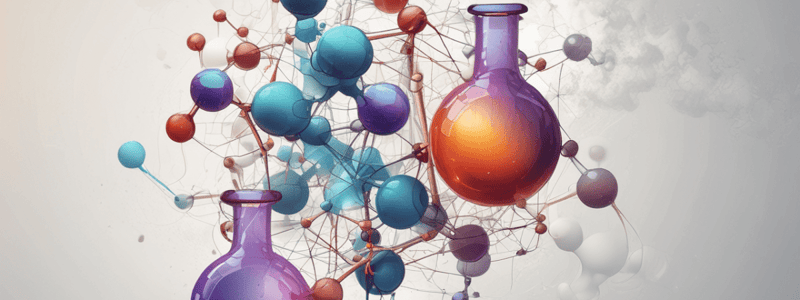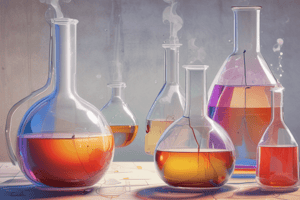Podcast
Questions and Answers
What is the purpose of manganese dioxide in the breakdown of hydrogen peroxide?
What is the purpose of manganese dioxide in the breakdown of hydrogen peroxide?
- To act as a catalyst to speed up the reaction (correct)
- To alter the particle size of the reactants
- To decrease the temperature of the reaction
- To increase the concentration of oxygen
What is the definition of a catalyst?
What is the definition of a catalyst?
- A substance that alters the rate of a chemical reaction and is chemically changed at the end of the reaction
- A substance that alters the rate of a chemical reaction, but is chemically unchanged at the end of the reaction (correct)
- A substance that slows down the rate of a chemical reaction
- A substance that increases the activation energy of a reaction
What is the term for the minimum energy required for colliding particles to react?
What is the term for the minimum energy required for colliding particles to react?
- Catalyst energy
- Reaction rate
- Particle energy
- Activation energy (correct)
What type of catalysis involves a catalyst in a different physical phase to the reactants?
What type of catalysis involves a catalyst in a different physical phase to the reactants?
What is the term for the rate at a particular point in time during a reaction?
What is the term for the rate at a particular point in time during a reaction?
What is the equation for the breakdown of hydrogen peroxide?
What is the equation for the breakdown of hydrogen peroxide?
What is the term for the change in concentration of any one reactant or product in unit time?
What is the term for the change in concentration of any one reactant or product in unit time?
What type of catalysis is involved in the intermediate formation theory?
What type of catalysis is involved in the intermediate formation theory?
What is the primary role of a catalyst in a chemical reaction?
What is the primary role of a catalyst in a chemical reaction?
What is the term for a collision that results in product formation?
What is the term for a collision that results in product formation?
What is the term for the accumulation of one substance at the surface of another?
What is the term for the accumulation of one substance at the surface of another?
What is the term for substances that can block active sites on a catalyst, reducing its effectiveness?
What is the term for substances that can block active sites on a catalyst, reducing its effectiveness?
How does the surface area of a catalyst affect the reaction rate?
How does the surface area of a catalyst affect the reaction rate?
What is the term for the energy barrier that must be overcome for a reaction to occur?
What is the term for the energy barrier that must be overcome for a reaction to occur?
What is the relationship between concentration and rate in a chemical reaction?
What is the relationship between concentration and rate in a chemical reaction?
What is the type of catalysis that occurs when the reactants are gases and the catalyst is a solid?
What is the type of catalysis that occurs when the reactants are gases and the catalyst is a solid?
What is the term for the rate of reaction found by drawing a tangent to the curve at a point?
What is the term for the rate of reaction found by drawing a tangent to the curve at a point?
Flashcards are hidden until you start studying




